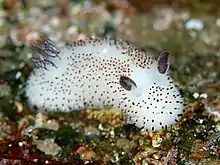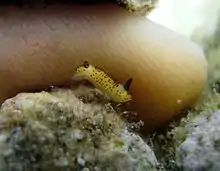Jorunna parva
Jorunna parva, popularly known as "sea bunny", is a species of dorid nudibranch, a shell-less marine gastropod mollusc in the family Discodorididae. It is found along the coasts of Korea, Japan, Palau, Philippines, Indonesia, Papua New Guinea, Australia, South Africa, Seychelles, and Tanzania.[3] The species was first described by Kikutaro Baba.[2] The resemblance of Jorunna parva's rhinophores to a rabbit's ears and its other features facilitated a surge in popularity on Twitter throughout Japan in 2015.[4] The rhinophores are classified as sensory organs for the act of chemoreception.[5] The rhinophores indeed enhances detection efficiency and allows Jorunna parva to sense its surrounding environment. The receptors allow these species to locate their mates and forage for food resources as well.[6] Sea bunnies, like many other nudibranchs, eat sponges, which contain toxins. Those toxins are used for cancer treatments.[6] A chemical compound called "jorumycin" has been found in a related species, Jorunna funebris.[7] This compound is a tetrahydroisoquinoline,[8] meaning it contains the same basic chemical backbone as an antitumor drug called PM00104, or Zalypsis,[7] which is meant to be injected intravenously.[9] Sea bunnies are considered to be one of 16 species in the family Discodorididae.[5] The fur is called caryophyllidia, which is composed of fleshy protuberances called papillae, as well as spicules, which are used for sensory functions.[10]
| Jorunna parva | |
|---|---|
 | |
| Jorunna parva | |
| Scientific classification | |
| Kingdom: | |
| Phylum: | |
| Class: | |
| (unranked): | clade Heterobranchia clade Euthyneura clade Nudipleura clade Nudibranchia clade Euctenidiacea clade Doridacea |
| Superfamily: | |
| Family: | |
| Genus: | |
| Species: | J. parva |
| Binomial name | |
| Jorunna parva | |
| Synonyms[2] | |
|
Thordisa parva Baba, 1938 | |

The Jorunna Parva are hermaphrodites, which means they produce both sperm and egg cells. They cannot fertilize the eggs themselves.[11] The sea bunnies additionally have different colors as well. There are yellow sea bunnies with black specks all around the body. There is also a greenish colored sea bunny, but photos are very rare.[11] Although the color differentiation is related to the Jorunna parva, there is controversy in whether or not the different colors are classified as divergent species.[11]
Distribution
This species was described from Kii Province, Japan. Jorunna parva has subsequently been reported from the Philippines, Tanzania, Papua New Guinea, Seychelles and Réunion but there are some doubts as to whether it is really a species complex.[12] The Jorunna parva are concentrated in areas where there is an abundance of food and where resources are easily acquired.[13] They often cling to submerged vegetation and spend majority of the time at the bottom of tropical waters.[14]
References
- Baba, K. (1938) Opisthobranchia of Kii, Middle Japan. Journal of the Dept of Agriculture, Kyushu Imperial University, 6(1): 1-19.
- Bouchet, P. (2010). Jorunna parva (Baba, 1938). World Register of Marine Species.
- Jung, Daewui; Lee, Jongrak; Kim, Chang-Bae (2013-04-01). "New Records of Four Doridoidean Nudibranchs from Korea". Animal Systematics, Evolution and Diversity. 29 (2): 191–197. doi:10.5635/ASED.2013.29.2.191. ISSN 2234-6953.
- Kearns, Landess (July 15, 2015). "Fluffy Bunny Sea Slugs Make Us Want To Cuddle Them". Huffington Post.
- "The Science of Sea Bunnies: You'll Never Believe The Top Ten List We Created To Get You To Visit Our Website". Deep Sea News. 2015-07-19. Retrieved 2017-12-01.
- "Meet the Adorable "Sea Bunny" Taking Over the Internet". National Geographic News. 2015-07-23. Retrieved 2019-04-13.
- Blunt, John W.; Copp, Brent R.; Munro, Murray H. G.; Northcote, Peter T.; Prinsep, Michèle R. (2011). "Marine Natural Products". Natural Product Reports. 28: 196–268 – via The Royal Society of Chemistry.
- "jorumycin - MeSH - NCBI". www.ncbi.nlm.nih.gov. Retrieved 2020-06-29.
- "Clinical Trial of PM00104 (Zalypsis®) in Patients With Advanced and/or Metastatic Endometrial or Cervical Cancer Previously Treated With One Line of Systemic Chemotherapy - Full Text View - ClinicalTrials.gov". clinicaltrials.gov. Retrieved 2020-06-29.
- Dr. M (July 19, 2015). "The Science of Sea Bunnies: You'll Never Believe The Top Ten List We Created To Get You To Visit Our Website". Deep Sea News. Retrieved November 30, 2017.
- Badore, Margaret (July 20, 2015). "The adorable science behind the "sea bunny"". Treehugger.com. Retrieved November 30, 2017.
- Rudman, W.B., 2000 (July 4) Jorunna parva? (Baba, 1938). [In] Sea Slug Forum. Australian Museum, Sydney.
- M, Dr (2015-07-19). "The Science of Sea Bunnies: You'll Never Believe The Top Ten List We Created To Get You To Visit Our Website". Deep Sea News. Retrieved 2019-04-13.
- "Sea Slug | Encyclopedia.com". www.encyclopedia.com. Retrieved 2019-04-13.
- Camacho-García Y.E. & Gosliner T.M. (2008). Systematic revision of Jorunna Bergh, 1876 (Nudibranchia: Discodorididae) with a morphological phylogenetic analysis. Journal of Molluscan Studies 74: 143-181
| Wikimedia Commons has media related to Jorunna parva. |